|
Judicial Decision and Disposition Disposition  Out-of-Home Placement. The dispositions used in adjudicated status offense cases varied according to the most serious offense involved in the case. Adjudicated cases involving charges of ungovernability or running away were the most likely to result in out-of-home placement in 1995 (table 56). Residential placement was far less common for adjudicated cases involving status liquor law violations or truancy. The likelihood of out-of-home placement for status offense cases in general decreased between 1986 and 1995 (from 19% to 16%). This drop stemmed from declines in the use of placement for runaway and ungovernable cases. Despite the drop in the overall proportion of adjudicated cases resulting in out-of-home placement, the number of adjudicated status offense cases that resulted in out-of-home placement increased 10% between 1986 and 1995 (table 57). However, the number of ungovernable and runaway cases involving juveniles placed out-of-home declined. 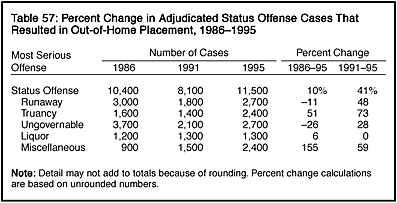 Of all formally handled status offense cases involving out-of-home placement in 1995, 23% were referred to court for running away, 23% for ungovernability, 21% for truancy, and 11% for status liquor law violations (table 58). 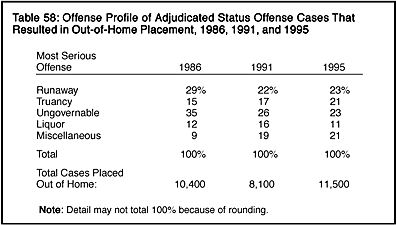 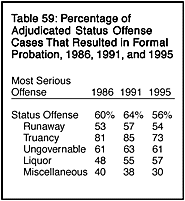 Formal Probation. In 1995, an order of formal probation was most likely in adjudicated truancy cases (73%) (table 59). Probation orders were less common among ungovernable cases (61%), liquor law violations (57%), and runaway cases (54%). Overall, the proportion of adjudicated status offense cases that resulted in formal probation decreased between 1986 and 1995 (from 60% to 56%). Despite the drop in the overall proportion of adjudicated cases ordered to probation, the total number of adjudicated status offense cases that resulted in formal probation increased 24% between 1986 and 1995 (table 60). Liquor law violations accounted for the largest share of this increase. The number of formal probation cases involving liquor law violation cases increased 45%, runaway charges increased 19%, and those involving truancy grew 18%. In contrast, probation cases involving ungovernability declined 11% between 1986 and 1995. 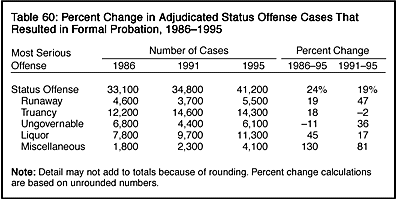 In 1995, 35% of the adjudicated status offense cases that resulted in probation involved truancy as the most serious charge, 27% involved liquor law violations, 15% involved ungovernability, and 13% involved running away (table 61). The 1995 offense profile of the formal probation caseload was not unlike the 1986 caseload, although there was a somewhat smaller proportion of ungovernability cases. 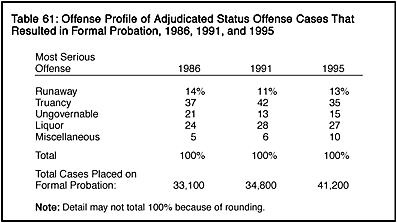
|